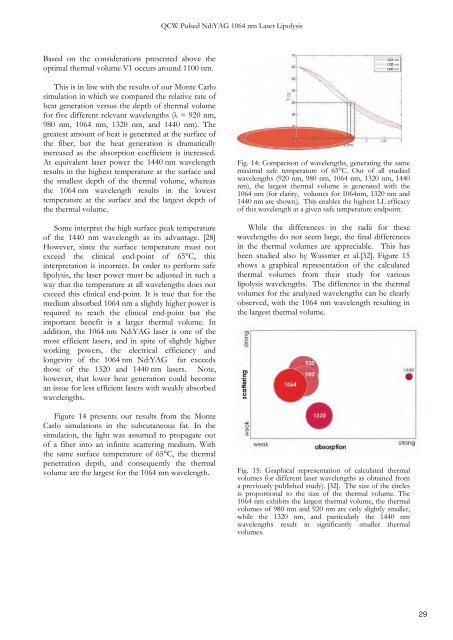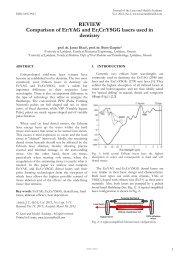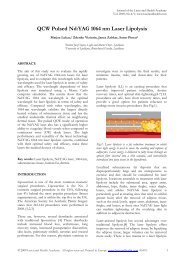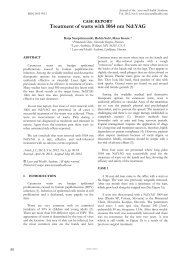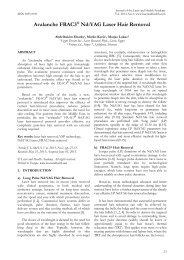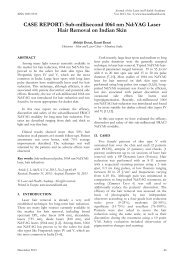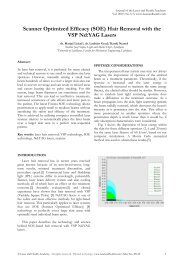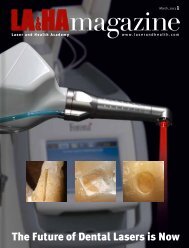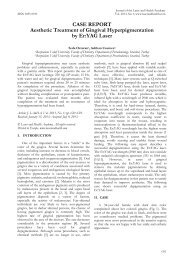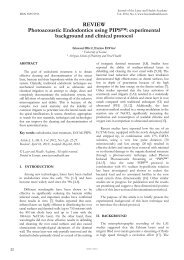QCW Pulsed Nd:YAG 1064 nm Laser Lipolysis - Laser and Health ...
QCW Pulsed Nd:YAG 1064 nm Laser Lipolysis - Laser and Health ...
QCW Pulsed Nd:YAG 1064 nm Laser Lipolysis - Laser and Health ...
Create successful ePaper yourself
Turn your PDF publications into a flip-book with our unique Google optimized e-Paper software.
Based on the considerations presented above the<br />
optimal thermal volume V1 occurs around 1100 <strong>nm</strong>.<br />
This is in line with the results of our Monte Carlo<br />
simulation in which we compared the relative rate of<br />
heat generation versus the depth of thermal volume<br />
for five different relevant wavelengths (� = 920 <strong>nm</strong>,<br />
980 <strong>nm</strong>, <strong>1064</strong> <strong>nm</strong>, 1320 <strong>nm</strong>, <strong>and</strong> 1440 <strong>nm</strong>). The<br />
greatest amount of heat is generated at the surface of<br />
the fiber, but the heat generation is dramatically<br />
increased as the absorption coefficient is increased.<br />
At equivalent laser power the 1440 <strong>nm</strong> wavelength<br />
results in the highest temperature at the surface <strong>and</strong><br />
the smallest depth of the thermal volume, whereas<br />
the <strong>1064</strong> <strong>nm</strong> wavelength results in the lowest<br />
temperature at the surface <strong>and</strong> the largest depth of<br />
the thermal volume.<br />
Some interpret the high surface peak temperature<br />
of the 1440 <strong>nm</strong> wavelength as its advantage. [28]<br />
However, since the surface temperature must not<br />
exceed the clinical end-point of 65°C, this<br />
interpretation is incorrect. In order to perform safe<br />
lipolysis, the laser power must be adjusted in such a<br />
way that the temperature at all wavelengths does not<br />
exceed this clinical end-point. It is true that for the<br />
medium absorbed <strong>1064</strong> <strong>nm</strong> a slightly higher power is<br />
required to reach the clinical end-point but the<br />
important benefit is a larger thermal volume. In<br />
addition, the <strong>1064</strong> <strong>nm</strong> <strong>Nd</strong>:<strong>YAG</strong> laser is one of the<br />
most efficient lasers, <strong>and</strong> in spite of slightly higher<br />
working powers, the electrical efficiency <strong>and</strong><br />
longevity of the <strong>1064</strong> <strong>nm</strong> <strong>Nd</strong>:<strong>YAG</strong> far exceeds<br />
those of the 1320 <strong>and</strong> 1440 <strong>nm</strong> lasers. Note,<br />
however, that lower heat generation could become<br />
an issue for less efficient lasers with weakly absorbed<br />
wavelengths.<br />
Figure 14 presents our results from the Monte<br />
Carlo simulations in the subcutaneous fat. In the<br />
simulation, the light was assumed to propagate out<br />
of a fiber into an infinite scattering medium. With<br />
the same surface temperature of 65°C, the thermal<br />
penetration depth, <strong>and</strong> consequently the thermal<br />
volume are the largest for the <strong>1064</strong> <strong>nm</strong> wavelength.<br />
<strong>QCW</strong> <strong>Pulsed</strong> <strong>Nd</strong>:<strong>YAG</strong> <strong>1064</strong> <strong>nm</strong> <strong>Laser</strong> <strong>Lipolysis</strong><br />
Fig. 14: Comparison of wavelengths, generating the same<br />
maximal safe temperature of 65°C. Out of all studied<br />
wavelengths (920 <strong>nm</strong>, 980 <strong>nm</strong>, <strong>1064</strong> <strong>nm</strong>, 1320 <strong>nm</strong>, 1440<br />
<strong>nm</strong>), the largest thermal volume is generated with the<br />
<strong>1064</strong> <strong>nm</strong> (for clarity, volumes for <strong>1064</strong><strong>nm</strong>, 1320 <strong>nm</strong> <strong>and</strong><br />
1440 <strong>nm</strong> are shown). This enables the highest LL efficacy<br />
of this wavelength at a given safe temperature endpoint.<br />
While the differences in the radii for these<br />
wavelengths do not seem large, the final differences<br />
in the thermal volumes are appreciable. This has<br />
been studied also by Wassmer et al.[32]. Figure 15<br />
shows a graphical representation of the calculated<br />
thermal volumes from their study for various<br />
lipolysis wavelengths. The difference in the thermal<br />
volumes for the analyzed wavelengths can be clearly<br />
observed, with the <strong>1064</strong> <strong>nm</strong> wavelength resulting in<br />
the largest thermal volume.<br />
Fig. 15: Graphical representation of calculated thermal<br />
volumes for different laser wavelengths as obtained from<br />
a previously published study). [32]. The size of the circles<br />
is proportional to the size of the thermal volume. The<br />
<strong>1064</strong> <strong>nm</strong> exhibits the largest thermal volume, the thermal<br />
volumes of 980 <strong>nm</strong> <strong>and</strong> 920 <strong>nm</strong> are only slightly smaller,<br />
while the 1320 <strong>nm</strong>, <strong>and</strong> particularly the 1440 <strong>nm</strong><br />
wavelengths result in significantly smaller thermal<br />
volumes.<br />
6/11<br />
29


